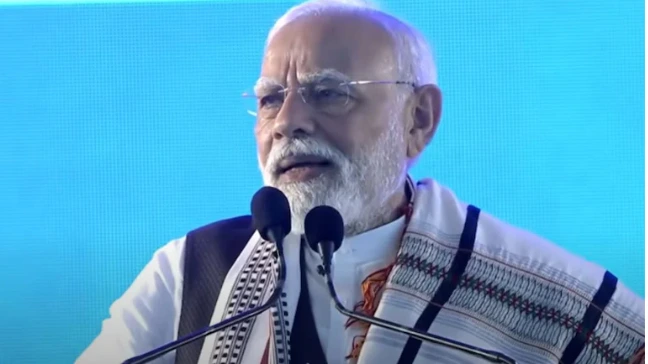Amid reports of falling rupee, rising fuel prices and joblessness, the Narendra Modi government finally has some good news that it came out with on Friday, August 31: the Indian economy recorded fastest growth in over two years to touch 8.2 per cent in the first quarter (April-June) of the 2018-19 fiscal.
Strong performance in manufacturing and consumer spending contributed to the growth that cemented India’s position as the fastest growing major economy ahead of China’s 6.7 per cent.
The gross domestic product (GDP) at constant (2011-12) prices in the first quarter of 2018-19 is estimated at Rs 33.74 trillion, as against Rs 31.18 trillion in Q1 of 2017-18, showing a growth rate of 8.2 per cent, according to a statement from Central Statistics Office (CSO).
Releasing the data, the CSO said in its statement that areas such as manufacturing, electricity and gas registered growth of over 7 per cent during the period.
“We are the fastest growing economy… Our economy is back on the track,” Economic Affairs Secretary Subhash Chandra Garg said. He also expressed hope growth could exceed estimates of 7.5 per cent this fiscal year.
“The GDP growth rate…indicates clearly that several structural reforms introduced such as GST have started giving rich dividends,” Finance Secretary Hasmukh Adhia said.
The high growth rate is aided by a low base effect — it stood at 5.6 per cent in April-June 2017.
In terms of Gross Value Added (GVA), the economy grew at 8 per cent in April-June this year compared with 5.6 per cent in April-June 2017. GVA represents the total output and income in the economy. As per the new methodology followed by CSO, the GDP is calculated by adding product taxes to the GVA at basic prices, and removing subsidies.
Manufacturing growth picked up significantly at 13.5 per cent during the period on the back of higher government expenditure giving households more money to spend. The manufacturing sector had witnessed a contraction of 1.8 per cent in Q1 last financial year. Private final consumption expenditure jumped 8.6 per cent in Q1 FY19 compared with 6.9 per cent in Q1 FY18.
For the full year, the government expects the economy to grow about 7.5 per cent. The RBI has forecast a GDP growth rate of 7.4 per cent for 2018-19. External headwinds including high oil prices that bring along the risks of imported inflation, and increased trade protectionism may impact exports.
“India’s GDP for the first quarter this year growing at 8.2% in otherwise an environment of global turmoil represents the potential of New India. Reforms and fiscal prudence are serving us well. India is witnessing an expansion of the neo middle class,” Finance Minister Arun Jaitley said in a tweet.
The construction sector growth jumped 8.7 per cent in Q1 FY19, from 1.8 per cent in Q1 FY18. Agricultural, forestry and fishing sector recorded growth of 5.3 per cent, up from 3.0 per cent, mainly due to more than a 15 per cent increase in production of rice, coarse cereals and pulses during rabi reason.
While manufacturing, construction and farm growth picked up pace, services sector growth largely fell during the quarter. Mining sector growth went down significantly to 0.1 per cent in Q1 FY 19, in contrast to 1.7 per cent in Q1 FY 18.
Analysts said since the first quarter growth was aided by low base year growth in first quarter, full growth is estimated at around 7.5 per cent.
Department of Economic Affairs Secretary Subhash Chandra Garg said that the V-shaped recovery of growth in Indian economy is complete now. “The Indian economy should grow at robust and steady state in full year, remaining the fastest economy in the world. Robust GDP performance in Q1 raises hope of exceeding estimates of 7.5 per cent for current fiscal,” he said.
Former Finance Minister P. Chidambaram said he is happy that the growth rate has quickened but it is based on the lowest base year growth of 5.6 per cent in the last eight quarters. “Going forward, the base effect will not be so favourable. And when we reach Q3 and Q4, the rate of growth may decline and the annual growth rate may be more or less like last year’s,” he said in a tweet.
Bibek Debroy, Chairman of the Economic Advisory Council to Prime Minister (EAC-PM), said that the growth numbers indicate “superior acceleration in India’s growth trajectory” and validate that the economic fundamentals remain robust.
“The encouraging growth rates in agriculture, manufacturing and construction show that the growth momentum continues to be broad-based. In addition, one also expects favourable monsoons to further boost agricultural output and rural consumption in the coming quarters,” Debroy said.
“While the recent fall in the rupee is likely to provide some support to exporters, rising global protectionism and slower global growth might limit the pickup in exports this year. Therefore, the major support to growth needs to come from a sustainable recovery in private consumption and investment,” CARE Ratings was reported to have said in a note ahead of release of GDP growth data release.
Key Highlights
- The growth in GDP is the highest growth in two years; strongest since Q1FY16.
- The economic activities which registered growth of over 7 per cent in Q1 of 2018-19 over Q1 of 2017-18 are ‘manufacturing, ‘electricity, gas, water supply & other utility services’ ‘construction’ and ‘public administration, defence and other services’.
- The growth in the ‘agriculture, forestry and fishing’, ‘mining and quarrying’, ‘Trade, hotels, transport, communication and services related to broadcasting’ and financial, real estate and professional services is estimated to be 5.3 per cent, 0.1 per cent, 6.7 per cent, and 6.5 per cent respectively during this period.
- Quarterly GVA at basic prices for Q1 2018-19 from ‘agriculture, forestry and fishing’ sector grew by 5.3 per cent as compared to growth of 3.0 per cent in Q1 2017-18.
- Quarterly GVA at basic prices for Q1 2018-19 from ‘manufacturing’ sector grew by 13.5 per cent as compared to growth of (-) 1.8 per cent in Q1 2017-18.
- Quarterly GVA at basic prices for Q1 2018-19 from ‘Electricity, Gas, water supply and other utility services’ sector grew by 7.3 per cent as compared to growth of 7.1 per cent in Q1 2017-18.
- Quarterly GVA at basic prices for Q1 2018-19 from ‘Construction’ sector grew by 8.7 per cent as compared to growth of 1.8 per cent in Q1 2017-18.
Core sector data
Eight core sectors grew by 6.6 per cent in July pushed by healthy output in coal, refinery products, cement and fertiliser. The eight core sector – coal, crude oil, natural gas, refinery products, fertilisers, steel, cement and electricity — had registered a growth of 2.9 per cent in July last year.
The output of coal, refinery products, fertiliser and cement grew by 9.7 per cent, 12.3 per cent, 1.3 per cent and 10.8 per cent respectively in July 2018.
However, growth rate in production of crude oil and natural gas recorded negative growth in the month of July.
On the other hand, steel sector expansion came down to 6 per cent, as against 9.4 per cent in July 2017.
During the April-July period of the current fiscal, these 8 sectors grew by 5.8 per cent as against 2.6 per cent in the year-ago period. In June, they grew by 7.6 per cent.


 India News22 hours ago
India News22 hours ago
 India News22 hours ago
India News22 hours ago
 Cricket news22 hours ago
Cricket news22 hours ago
 India News7 hours ago
India News7 hours ago
 India News7 hours ago
India News7 hours ago
 Latest world news7 hours ago
Latest world news7 hours ago
 India News2 hours ago
India News2 hours ago
 Entertainment2 hours ago
Entertainment2 hours ago













